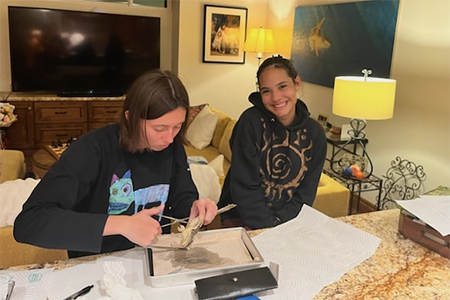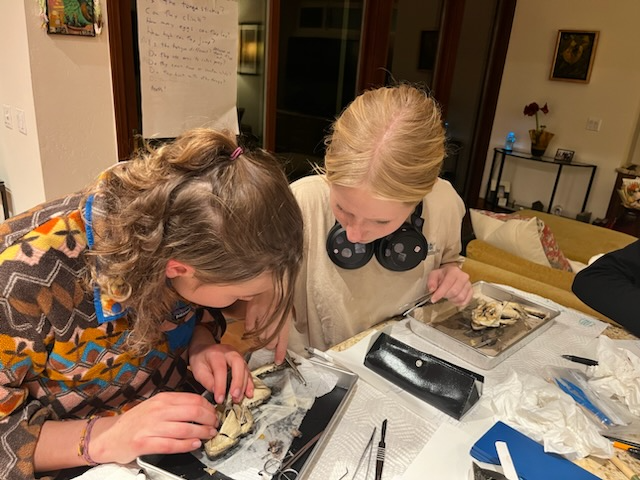Evaluating Alternatives to Dissection with the SynFrog
By Peter A'Hearn, CASE Past President
At the 2023 California Science Education Conference in Palm Springs, the Keynote Speaker was the inspiring Dr. Tyrone Hayes, who introduced himself as “a boy who loved frogs.” I asked him after the keynote, how he felt about frog dissection, and he replied that when he had to do it as part of his research, it was one of the hardest things he had to do.
To find out, I gathered a small group of scouts from my daughter’s Scouts BSA Troop to compare a real frog to the SynFrog. Three of the scouts were from the Frog Patrol so it seemed appropriate. Thanks to Samantha Crowe from Teach Kind Science/PETA for supplying the SynFrog.
We followed this protocol, based on the process I learned from Monterey Bay Aquarium. At the end, the scouts shared their thoughts and impressions. The Scouts were:
- Allison Turley (18) Eagle Scout, Frog Patrol
- Maarit A’Hearn (17) Eagle Scout, Frog Patrol
- Irie Paris (16) Star Scout, Butter Duck Patrol
- Penny O’Brien (15) Star Scout, Frog Patrol


Photos by Peter A'Hearn
Comparison of the realism of the SynFrog and the real frogs:
Allison: “Overall I liked handling the real frog better. I like looking at the details (balls on the feet, vasculature, eyelids, linings of the organs). The artificial frog had the main components and structures but lacked anatomical details.
Penny: “The real frog was better for having all of the holes that a frog has.”
Allison: “I will say the artificial frog’s organs were easier to identify due to their varying colors, accurate shapes, and correct placement. The real frog was more confusing at times since the organ’s structure was affected by the preservative (slightly shriveled and all a similar color).
Maarit: “The fake frog was a lot less realistic–it didn’t include a nose hole, mouth hole, butt, or teeth. It wasn’t very accurate at all, and doesn’t give you the feel of a dissection.”
Allison: “The artificial frog felt similar to the real frog, especially its skin and the fact that liquid was contained in the inside. I appreciated the thought put into the artificial frog to replicate the experience of dissecting a real frog that has been done for generations.”
On how they felt about the SynFrog and the real frogs:
Penny: “I liked the fake frog because there was less fear about the intestines.”
Maarit: “I thought the real frogs were very scary to look at–I almost didn’t want to touch them and I got a bit dizzy after a while.”
Thoughts on the ethics of using the SynFrog and the real frogs:
Irie: “[The real frog isn’t] good because I’m really big on the value of life and I don’t think people should disrespect the frogs like that.”
Maarit: “I do agree that ethically it feels better to touch and use the fake frog.”
Allison: “Ethically, I am not opposed to the use of animals for dissection as long as they are sourced ethically. I think it is valuable to learn on things that were once living, however, I am also passionate about the environment and know that the farming of these animals (or hunting) can have a negative impact.”
Penny: “After a while I felt desensitized, I felt like the frog was not a previously alive animal before. [This bothered me]”
On what should be used in classrooms:
Allison: “Objectively the real frog wins when looking from an anatomical standpoint, but the artificial frog was accurate enough to learn from in a high school classroom setting.”
Penny: “I think kids should have the option of choosing real versus fake.”
Maarit: “I’d use the real frogs.”
Irie: “Although the fake frog is more humane, comparing the costs between them in public schools it makes more sense to use the real frogs. [I think] doing online simulations is the best option.”
Allison: “High schools likely cannot afford to purchase synthetic frogs, leaving real frogs as a more realistic option. If the fake frogs were to be made less expensive, more accurate, and more accessible, I believe they are a good option to be implemented in high school classrooms. Real frogs can be used in upper division classes, with synthetic frogs being used alongside to address the ethical and environmental concerns of real frogs.

Although a small group, these students had a wide diversity of opinions and feelings and show that decisions about dissections are not simple. Teachers need to be aware that the law in California allows students who object to opt out of dissections and be given an alternate assignment. Teachers need to make sure that students are aware of this option. The article by PETA in this issue provides many excellent options for students and teachers who want to avoid dissections.




